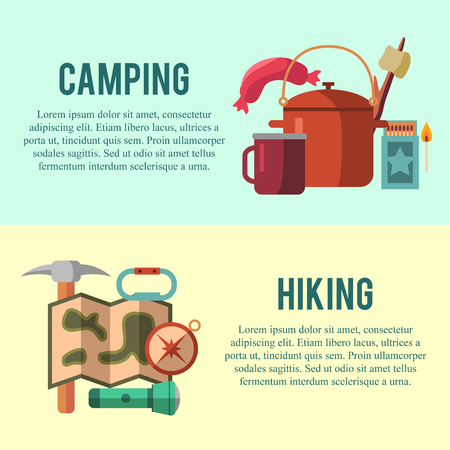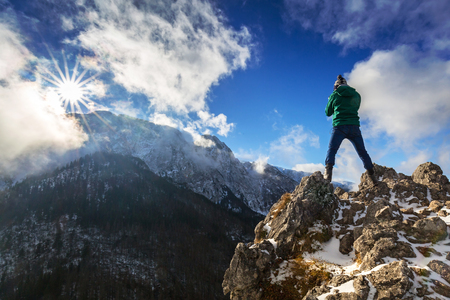1. Understanding American Trails and Terrain
When it comes to hiking in the United States, no two trails are quite the same. The country offers an incredible range of landscapes, each presenting its own set of challenges and needs when selecting a backpack. Whether you’re trekking through the jagged peaks of the Rockies, winding your way under the towering redwoods of California, or exploring the lush, rolling forests of the Appalachians, understanding the terrain is essential for making the right gear choices.
Why Terrain Matters for Backpack Selection
The type of trail and landscape directly affects what you should pack and how much weight youll be comfortable carrying. For example, steep mountain hikes often require lighter, more compact packs to help with balance and agility. In contrast, longer treks through remote wilderness areas may demand larger backpacks to carry extra food, water, and gear.
Common U.S. Hiking Terrains and Backpack Needs
| Region | Terrain Features | Backpack Considerations |
|---|---|---|
| Rocky Mountains | High elevation, rugged paths, unpredictable weather | Lightweight pack, good suspension system, weatherproof materials |
| Pacific Northwest | Damp forests, muddy trails, frequent rain | Water-resistant pack, durable zippers, ventilation features |
| Appalachian Trail | Lush forests, rolling hills, moderate elevation changes | Comfortable straps for long days, medium capacity (40-60L), easy-access pockets |
| Southwest Deserts (Grand Canyon, Zion) | Arid climate, rocky ground, temperature swings | Hydration compatibility, breathable back panel, sun protection features |
| Sierra Nevada & California Coast | Mixed elevations, varying climates from hot valleys to cool peaks | Adjustable fit for changing layers, external attachment points for gear |
Tip:
If you’re unsure about the specific conditions on your chosen trail, check with local ranger stations or online hiking communities. American hikers love to share tips and up-to-date trail info!
2. Sizing Up: Choosing the Right Backpack Capacity
Picking the perfect backpack size is key to a smooth hiking experience in the U.S. Whether you’re planning a quick day hike in Yosemite, a weekend escape to the Great Smoky Mountains, or a multi-day trek through the Rockies, your pack should match your adventure’s length and style. Here’s how to find the right fit for your American outdoor journey:
Backpack Volume Basics
Backpack capacity is measured in liters (L), and the right volume depends on how long you’ll be out and what you need to carry. Check out this simple guide:
| Trip Length | Recommended Capacity | What It Fits |
|---|---|---|
| Day Hike (1 day) | 15–30L | Water, snacks, first aid kit, extra layer, small essentials |
| Weekend Trip (1–3 nights) | 30–50L | Tent, sleeping bag, food, stove, clothes, all basics |
| Multi-Day Adventure (4+ nights) | 50–70L+ | All camping gear, extra food & water, clothing for any weather, luxury items |
Day Packs: For Quick American Getaways
If you’re hitting popular trails like Angels Landing in Zion or Runyon Canyon in Los Angeles for just a few hours, a 15–30L pack does the trick. It’s light and easy to carry but still holds your must-haves—water bottle, snacks, sunscreen, and a rain jacket.
Weekend Packs: For Short Backcountry Trips
A 30–50L pack is ideal if you’re spending a night or two outdoors—think camping along the Appalachian Trail or backpacking in Shenandoah. There’s room for your sleeping gear and enough food without overloading your back.
Extended Trips: Multi-Day Backpacking in America’s Wild Places
Tackling longer treks like the John Muir Trail or sections of the Pacific Crest Trail? Go with a 50–70L+ pack. These larger packs are made to hold everything you need for several days in remote areas—including extra layers for changing weather and all your camp kitchen gear.
Packing Tip: Keep It Comfortable!
No matter which size you choose, try not to overpack. Aim for a loaded pack weight that’s no more than 20–25% of your body weight. This keeps your hike fun and safe—even when those Rocky Mountain switchbacks get steep.

3. Key Features and Comfort for the U.S. Hiker
When it comes to hiking across the diverse terrains of America, comfort and practical features are essential in a backpack. U.S. hikers value gear that keeps them hydrated, cool, and organized—especially on those long days out on the trail. Here’s what you should look for:
Hydration Compatibility
Staying hydrated is non-negotiable while trekking in places like the Rockies or the Grand Canyon. Most modern hiking backpacks for American trails come with hydration sleeve compatibility, allowing you to easily slip in a water reservoir (like a CamelBak) and sip through a hose without needing to stop and dig out your water bottle.
Ventilation Systems
Nobody likes a sweaty back after hours on dusty switchbacks! Ventilated back panels—often made with mesh or suspended trampoline-style designs—help keep airflow moving between you and your pack, reducing sweat and keeping you more comfortable as temperatures climb.
Adjustable Suspension
Backpacks aren’t one-size-fits-all. Adjustable suspension systems let you customize the fit to your torso length and shoulder width, which is especially important for American hikers who might be tackling anything from short Appalachian hikes to multi-day journeys through national parks. Proper adjustment distributes weight evenly, preventing sore spots and fatigue.
Easy Accessibility
You don’t want to unpack everything just to grab your rain jacket or trail snacks. Look for backpacks with multiple access points—top-loading, front zipper panels, or side pockets—to make grabbing gear quick and easy while you’re on the go.
Comparison Table: Must-Have Backpack Features for American Hikers
| Feature | Why It Matters | Typical Use on U.S. Trails |
|---|---|---|
| Hydration Sleeve | Keeps water accessible at all times | Long treks, hot climates like Arizona or Utah |
| Ventilated Back Panel | Reduces sweat and increases comfort | Summer hikes, humid East Coast forests |
| Adjustable Suspension | Ensures proper fit and load distribution | Multi-day trips in the Rockies or Sierras |
| Multiple Access Points | Makes gear retrieval easier on the trail | Day hikes, unpredictable weather conditions |
| Padded Hip Belt & Shoulder Straps | Adds comfort when carrying heavy loads | Backpacking trips in national parks like Yellowstone or Yosemite |
Selecting a backpack with these features will make your next American hiking adventure safer, more comfortable, and way more enjoyable—so keep them top of mind while shopping for your perfect pack!
4. Fit and Try-On Tips at Your Local Outdoor Store
Finding the perfect backpack isn’t just about picking the coolest style or the most popular brand—it’s all about fit and comfort, especially when you’re prepping for an American hiking adventure. Here’s how to make sure your backpack feels great from the first mile to the last, using tips tailored for visits to stores like REI, Backcountry, or your favorite local outfitter.
Why In-Store Fitting Matters
Trying on backpacks in person lets you get a real feel for size, weight distribution, and adjustability. Store staff at places like REI are super knowledgeable and can help with personalized fitting advice. Plus, many locations have weighted bags you can load into packs to simulate a real hiking scenario.
Steps for Proper Backpack Fitting
| Step | What to Do | Why It Matters |
|---|---|---|
| 1. Measure Your Torso Length | Ask staff to help measure from your C7 vertebra (base of neck) down to your hip bones. | This ensures the pack fits your body, not just your height. |
| 2. Adjust Hip Belt First | Place the pack on your hips so the belt sits snugly over your iliac crest (top of your hip bones). | The hip belt should carry most of the weight—about 80%. |
| 3. Tighten Shoulder Straps | Pull straps until the pack hugs your shoulders without pinching or gapping. | Keeps the pack stable and close to your back. |
| 4. Set Load Lifters & Sternum Strap | Adjust these straps so the top of the pack tilts slightly forward and chest strap sits comfortably. | Improves balance and prevents shoulder strain. |
| 5. Walk Around & Move | Bend, squat, twist, and walk around the store for a few minutes. | Makes sure nothing rubs or digs in during real hikes. |
Packing Test: Simulate a Real Hike
Ask if you can load up the backpack with sandbags or demo gear. This extra step helps you experience how it will actually feel on-trail—heavy, but balanced. Pay attention to pressure points on shoulders and hips, and see if any features dig in or shift while moving.
Comfort Checkpoints
- No Pinching: The hip belt should be snug but not tight enough to pinch skin or cause discomfort after a few minutes.
- No Gaps: Shoulder straps should contour smoothly without floating above your shoulders or digging in.
- Straight Posture: You should be able to stand upright without leaning forward or backward unnaturally.
- Easy Adjustments: Try making quick adjustments on the fly—you’ll need this flexibility during a hike!
- Ventilation: Look for mesh panels or airflow channels along the back panel for those hot summer days in American national parks.
Pro Tip from American Hikers:
If possible, wear the same base layers or jackets you plan to hike in when trying on packs at the store. This gives you a more accurate sense of fit and comfort on trail days.
5. Brands, Budgets, and Where to Shop in the U.S.
Picking the perfect backpack for your American hiking adventure isn’t just about size and fit—it’s also about finding the right brand, staying within your budget, and knowing where to shop for the best value. Here’s how you can navigate these important decisions:
Popular American Backpack Brands
The U.S. has a wide variety of outdoor gear brands known for quality, durability, and innovation. Here’s a quick comparison of some top choices:
| Brand | Best For | Price Range | Notable Features |
|---|---|---|---|
| Osprey | Versatility & Comfort | $100–$350+ | Lifetime warranty, adjustable suspension systems |
| Deuter | Back Support & Long Treks | $120–$300 | Ergonomic design, ventilation technology |
| Gregory | Custom Fit & Organization | $140–$350+ | Molded hip belts, specialized pockets |
| The North Face | Everyday Use & Short Trips | $80–$250 | Urban-outdoor style, reliability |
| REI Co-op | Value & Sustainability | $70–$220 | Eco-friendly materials, great warranties |
| Hyperlite Mountain Gear | Ultralight Hiking & Thru-Hikes | $300–$400+ | Cuben fiber construction, minimal weight |
Budget Considerations: How Much Should You Spend?
Your budget will depend on how often you hike and what features matter most to you. Here are some tips:
- Entry-Level ($50–$100): If you’re new to hiking or only go out occasionally, you’ll find basic packs with fewer features but reliable enough for short trips.
- Mid-Range ($100–$200): This is the sweet spot for most hikers—expect better support, more compartments, and added comfort.
- Premium ($200+): If you’re planning multi-day adventures or want top-notch materials and design, it’s worth investing in a high-end backpack from a trusted brand.
Pro Tip:
You don’t have to buy the latest model; last season’s packs are often on sale and offer great value.
Where to Shop: Online vs. In-Store in the U.S.
| Option | Main Benefits | Best For |
|---|---|---|
| Online Retailers (REI.com, Backcountry.com, Amazon) |
Larger selection User reviews Frequent sales/discounts |
Bargain hunters Picky shoppers |
| Physical Stores (REI stores, Dicks Sporting Goods, Local Outfitters) |
Try before you buy Personalized fitting help Loyalty programs |
First-time buyers Packs that need fitting adjustments |
Navigating Sales and Deals:
- Watch for major sales events like REI’s Anniversary Sale (May) and Labor Day deals.
- If shopping online, check return policies—some stores like REI offer generous returns if your pack doesn’t fit right after a trial hike.
- Don’t forget about outlet stores or factory seconds for big savings on top brands!
Your Next Steps:
Create a wish list of must-have features, set your budget range, then test out packs in-store or order from retailers with easy returns. With so many excellent options available in the U.S., you’ll be ready to hit the trails with confidence—and maybe even save a few bucks along the way!


